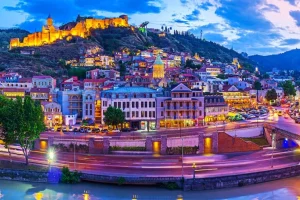Let’s be honest. You can see the Golden Pavilion in Kyoto and scramble across the Shibuya Crossing. But to truly understand Japan, you have to taste it. And I mean really taste it. The real magic, the soul of this country, isn’t found in the neon-lit convenience stores of Tokyo—it’s simmering in a pot over a hearth in a 300-year-old farmhouse in the Japanese Alps.
That’s the deal with cultural immersion through food in rural Japan. It’s not just a meal; it’s a conversation. A story told through pickles, through broth, through the calloused hands of an obaa-san (grandmother) who’s been making the same miso for fifty years. Let’s dive in.
Beyond Sushi: The Heart of Japanese Food Culture
Sure, sushi is incredible. But it represents only a tiny slice of the culinary landscape. Rural Japan, or the inaka, is where the foundational elements of Japanese cuisine are preserved. This is the world of satoyama—the border zone between mountain foothills and flat land. Here, the food is deeply connected to the seasons, the land, and a spirit of self-sufficiency.
We’re talking about a culinary philosophy called “shun” (旬). It means eating ingredients at the peak of their freshness and flavor. In the city, you can get strawberries year-round. In a village in Nagano, you eat them in spring, wild mountain vegetables (sansai) in early summer, and hearty root vegetables and preserved foods in the deep winter. The calendar dictates the menu.
What You’re Actually Tasting
The flavors here are… different. More profound, maybe. They have a sense of place, a terroir, as the French would say.
- Umami Unleashed: This is where you’ll taste the deepest, most complex dashi (broth) made from katsuobushi (bonito flakes) shaved right off the block and local kombu (kelp). It’s the base of everything.
- Fermentation Nation: Rural Japan runs on fermented foods. Miso, soy sauce, pickles (tsukemono), and even fish (narezushi, the ancient precursor to sushi) are crafted in homes using methods passed down for generations. Each family’s miso tastes slightly different—a unique fingerprint of their household.
- Wild & Foraged: It’s common to see locals foraging for bamboo shoots in spring or mushrooms in autumn. This connection to the untamed land is a core part of the food culture you simply won’t find in a city market.
How to Find These Authentic Food Experiences
Okay, so you’re convinced. But how do you, as a traveler, actually access this? It’s not always listed on TripAdvisor. Here are a few ways to go beyond the restaurant menu.
1. Stay at a Ryokan or Minshuku with Meals
This is your golden ticket. A ryokan (traditional inn) or a more casual minshuku (family-run guesthouse) often serves kaiseki-style dinners. This is a multi-course feast that is a work of art, showcasing the very best local and seasonal ingredients. You’re not just a customer; you’re a guest in someone’s home, eating what the family eats.
2. Participate in a Cooking Class or Food Workshop
Don’t just eat the soba noodles—learn to make them. In places like Nagano or Gifu, you can find hands-on workshops where you grind buckwheat, knead the dough, and roll it out by hand. It’s harder than it looks, honestly. Other incredible workshops focus on:
- Miso-making
- Traditional pickling (tsukemono)
- Crafting your own rice crackers (senbei)
3. Visit a Local Market or an Aki-ichi (Autumn Festival)
Forget the massive, tourist-oriented tuna auctions. Seek out a small, local morning market. The Miyagawa Morning Market in Takayama is a perfect example. Farmers sell their wares directly. You can taste homemade pickles, sample local sake, and buy strange, mountain-grown vegetables you’ve never seen before. It’s a vibrant, chaotic, and delicious glimpse into daily life.
4. Dine at a Jizakaya (a “local’s only” pub)
This takes a bit of courage, but the reward is immense. A jizakaya is a tiny, often unassuming pub that caters almost exclusively to locals. There’s no English menu—there might not be any menu at all. You point at what other people are eating or at the ingredients behind the glass. The food is simple, robust, and incredibly cheap. It’s a place for laughter, strong drinks, and genuine connection.
A Taste of Place: Regional Rural Specialties to Seek Out
| Region/Prefecture | Must-Try Local Dish | What Makes It Special |
| Ishikawa (Noto Peninsula) | Kaisen Don (Seafood Bowl) | Fresh-caught seafood from the Sea of Japan, often including uni (sea urchin) and crab, served over rice. The quality is staggering. |
| Nagano | Soba (Buckwheat Noodles) | The cool climate is perfect for growing buckwheat. The noodles are chewy, nutty, and served with a intense, dipping broth. |
| Yamagata | Imoni (Taro Stew) | A hearty, communal stew enjoyed outdoors in autumn. It features taro root, meat, and vegetables in a miso or soy sauce broth. |
| Kochi | Katsuo no Tataki | Skipjack tuna seared over straw for a smoky exterior and raw interior, served with garlic, ginger, and ponzu. It’s a flavor explosion. |
The Unspoken Rules: Etiquette for the Rural Food Traveler
Showing respect is just as important as showing up with an appetite. A few things to keep in mind…
- Itadakimasu and Gochisousama: Always say “itadakimasu” (ee-tah-dah-kee-mas) before you eat. It means “I humbly receive.” After the meal, say “gochisousama deshita” (go-chee-so-sama desh-ta), which is a thank you for the feast. It’s not just polite; it’s expected.
- Slurp Your Noodles: Seriously. Slurping ramen or soba is a sign of enjoyment. It also, apparently, aerates the noodles and enhances the flavor.
- Try Everything: Even if it looks unfamiliar. The act of being adventurous and appreciative will be noticed and warmly received. It builds a bridge.
- Handle Your Chopsticks Right: Don’t stick them upright in your rice (it’s a funeral rite). And don’t pass food from your chopsticks to someone else’s (another funeral-related practice).
Look, the goal here isn’t to just check a box. It’s to sit on a tatami mat, your legs going slightly numb, as the owner of a minshuku brings you a dish of wild mountain vegetables she foraged that morning. You taste the slight bitterness, the essence of the forest. And in that moment, you’re not just a tourist passing through. You’re a participant in a cycle that’s been turning for centuries. You’re not just eating Japan. You’re living it.





